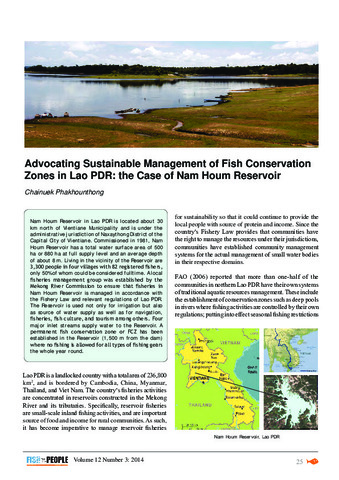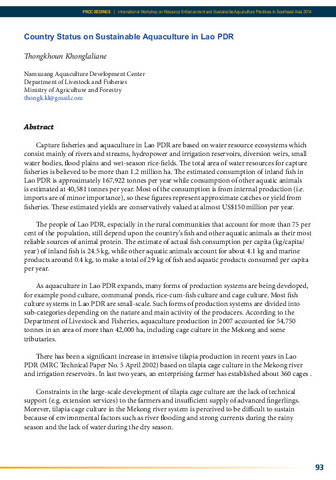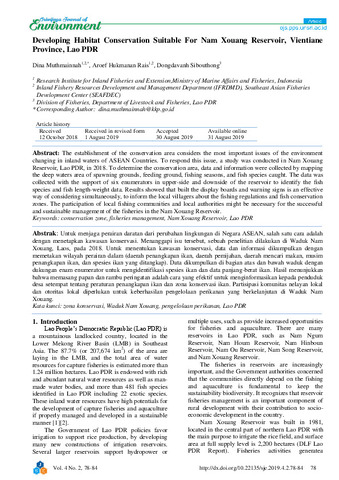Advocating sustainable management of fish conservation zones in Lao PDR: the case of Nam Houm reservoir
Share
Abstract
Nam Houm Reservoir in Lao PDR is located about 30 km north of Vientiane Municipality and is under the administrative jurisdiction of Naxaythong District of the Capital City of Vientiane. Commissioned in 1981, Nam Houm Reservoir has a total water surface area of 500 ha or 880 ha at full supply level and an average depth of about 8 m. Living in the vicinity of the Reservoir are 3,300 people in four villages with 82 registered fishers, only 50% of whom could be considered fulltime. A local fisheries management group was established by the Mekong River Commission to ensure that fisheries in Nam Houm Reservoir is managed in accordance with the Fishery Law and relevant regulations of Lao PDR. The Reservoir is used not only for irrigation but also as source of water supply as well as for navigation, fisheries, fish culture, and tourism among others. Four major inlet streams supply water to the Reservoir. A permanent fish conservation zone or FCZ has been established in the Reservoir (1,500 m from the dam) where no fishing is allowed for all types of fishing gears the whole year round.
Suggested Citation
Phakhounthong, C. (2014). Advocating sustainable management of fish conservation zones in Lao PDR: the case of Nam Houm reservoir. Fish for the People , 12(3), 25-32. http://hdl.handle.net/20.500.12066/945
Subject
Koleksi
Related items
Showing items related by title, author, creator and subject.
-
Country status on sustainable aquaculture in Lao PDR
Khonglaliane, Thongkhoun (Aquaculture Department, Southeast Asian Fisheries Development Center, 2015)Capture fisheries and aquaculture in Lao PDR are based on water resource ecosystems which consist mainly of rivers and streams, hydropower and irrigation reservoirs, diversion weirs, small water bodies, flood plains and ... -
Developing habitat conservation suitable for Nam Xouang Reservoir, Vientiane Province, Lao PDR
Muthmainnah, Dina; Hukmanan Rais, Aroef; Sibouthong, Dongdavanh (Graduated Program Sriwijaya University, 2019-08-31)The establishment of the conservation area considers the most important issues of the environment changing in inland waters of ASEAN Countries. To respond this issue, a study was conducted in Nam Xouang Reservoir, Lao PDR, ... -
Current Status of Fish Stock Enhancement in Thailand
Ingthamjitr, Suchart; Sricharoendham, Boonsong (Training Department, Southeast Asian Fisheries Development Center, 2016)Aquatic animals from natural waters have long been exploited by rural poor as cheap protein food. Natural waters including rivers, canals, swamps, lakes, large reservoirs, and small water bodies are significantly exploited ...





